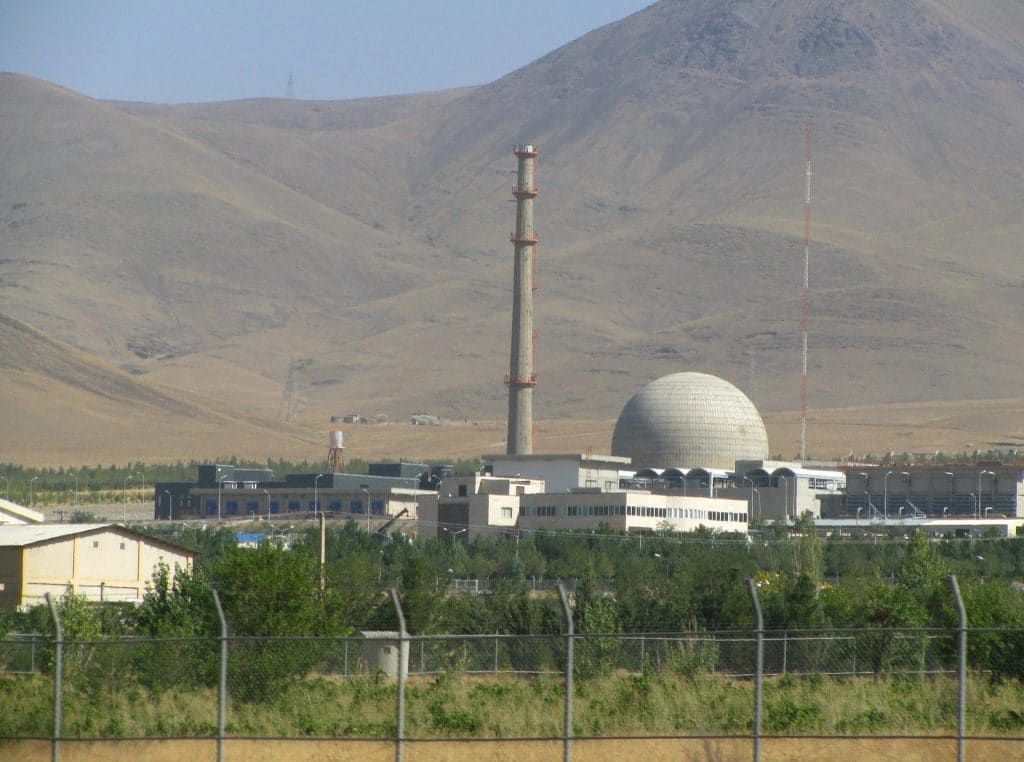How Iran’s research reactors prove the nuclear deal is still working
By Samuel M. Hickey | August 11, 2021
 Arak IR-40 heavy water reactor, Iran. Credit: Nanking2012. CC BY-SA 3.0 Accessed via Wikimedia Commons.
Arak IR-40 heavy water reactor, Iran. Credit: Nanking2012. CC BY-SA 3.0 Accessed via Wikimedia Commons.
An underexamined success story from the 2015 Iran nuclear deal negotiations is the effective blocking of Tehran’s ability to collect plutonium for a nuclear bomb. Not only has the nuclear deal, known officially as the Joint Comprehensive Plan of Action (JCPOA), been effective in constraining Iran’s program, but it could, suitably adapted, provide a standard of guidance for research reactor construction that would lower proliferation risks worldwide.
There are two pathways to get the fissile material to fuel a nuclear bomb. The first is to enrich uranium, and the second is to recover plutonium from the spent fuel of a reactor. The JCPOA blocked both pathways. Now, Iran’s advancing enrichment program is the key obstacle for diplomats trying to revive the deal, and those talks have dragged on for months as the program marches forward.
Many nuclear weapons, including that used on Hiroshima, are uranium-based. However, every country that has a nuclear weapon has produced and separated plutonium for weapons. Iran has not reopened this path despite efforts by its conservative-dominated parliament to pressure the United States to lift sanctions in return for nuclear deal compliance. In December 2020, Iran passed a nuclear law requiring a return to a threatening research reactor design. So far, Iran has not adhered to that law because the modifications made to the original design under the JCPOA made the reactor even more efficient. This suggests that even in its weakened state, the JCPOA continues to provide permanent solutions to potential proliferation concerns. Its revival can further cement these gains as a “longer and stronger” deal is sought.
The inherent problem with nuclear reactors. Here’s the conundrum for nuclear negotiators both with Iran now and potentially with other countries in the future: Given enough time, all civilian research reactors will produce enough plutonium for a nuclear weapon that could be reprocessed—or separated from irradiated uranium—in their spent fuel. Some, like Iran’s Arak heavy water research reactor, as originally designed, are particularly well suited for plutonium production but also have civilian purposes such as medical radioisotope production and the testing of nuclear fuel and materials. Argentina, Brazil, South Korea, Sweden, and Taiwan have considered acquiring reprocessing plants but eventually demurred, given international reaction to the potential for proliferation. There is no public evidence that Iran has a reprocessing facility.
Since the Trump administration pulled out of the JCPOA, Iran has introduced advanced centrifuges and stockpiled uranium. This means that the amount of time for Iran to pursue a nuclear weapon via the enriched uranium path has been significantly decreased. However, the spent fuel pathway has not been reactivated as Iran has not done any work to reconstruct the Arak heavy water research reactor to its original design nor has it engaged in any reprocessing activities. Iran’s hedging strategy, ostensibly to accumulate leverage in negotiations to revive the JCPOA, suggests that nuclear brinksmanship with uranium enrichment grants a certain flexibility that plutonium does not.
How did the JCPOA prevent plutonium recovery? Initially, the Arak heavy water research reactor represented a serious proliferation threat because it was a plutonium-producing machine. As originally designed, the Arak reactor could produce enough plutonium in its spent fuel for one or two nuclear bombs per year. Construction of the Arak reactor was coming to completion when nuclear talks were beginning and the inclusion of a freeze on construction actually held up the conclusion of the 2013 Joint Plan of Action, which preceded the JCPOA. Groups of independent scientists, including Ali Ahmad, Frank von Hippel, Alexander Glaser, and Zia Mian, suggested new designs for the reactor that would rely on low-enriched uranium.
Eventually, Iran made the following proposal for the Arak reactor: to operate the reactor at half its original power; to modify the core size (height from 3.4 to 1.1 meters and core diameter from 3.4 to 2.4 meters); and to only use fuel enriched up to 3.67 percent, or low-enriched uranium. The new design reduced plutonium production from 11 kilograms (24.25 pounds) per year to about 1.2 kilograms (2.65 pounds) per year, meaning it would take Iran much longer than one year to produce a quantity sufficient for a nuclear weapon.
The JCPOA also required that Iran ship out its plutonium-containing spent fuel for the Arak reactor, likely to Russia, in perpetuity so that at no point would Iran be able to use the Arak reactor to recover plutonium. This is the critical provision that, if universalized, could mark an end to civilian research reactors providing cover for a secret nuclear weapons interest. As long as spent fuel can be accumulated, plutonium production for a nuclear weapon remains on the table.
Lessons learned from the JCPOA. According to Behrouz Kamalvandi, spokesman for the Atomic Energy Organization of Iran, “Our experts believe that the redesigned reactor is more efficient for research and we should complete it. This means that building a reactor like the original reactor has to start from scratch in another location.” This statement says it all. Not only did the JCPOA achieve a much less dangerous reactor, but it is in Iran’s interests to keep it so since it is a more efficient design. In order to reconstitute the plutonium pathway to a nuclear bomb, Iran would need to start over somewhere else.
There are about 220 research reactors operating in 53 countries around the world. Some still use fuel enriched to about 93 percent, but the international community has made great strides in converting these reactors to low-enriched uranium. Looking to the future, the modifications made to the Arak reactor could provide a technical standard for any new construction of heavy water research reactors.
An equally important component is the agreement to ship out spent fuel to another country. Here’s the problem: Most countries are loath to accept spent fuel because it could present a radiological hazard and is unpopular domestic politics. Since research reactors produce so little spent fuel, those concerns can still be addressed with each new negotiation, even if it is hard to see how in the short term.
Shipping spent fuel to the nuclear weapon states is the most logical answer because of the potential to recover plutonium for a nuclear weapon. However, the United States has struggled to dispose of its own weapon-grade plutonium that it produced between 1944 and 1994, so it is not clear at this time who has the capacity or the political willingness to accept this burden.
Still, the interest in preventing further proliferation could merit general global guidelines for new construction, including technical constraints and spent fuel removal. Russia has signaled willingness to accept spent fuel, although it already faces significant challenges from its own nuclear waste. Both the United States and Russia already possess quantities of plutonium far in excess of that needed for their weapons programs, so accepting spent fuel would not pose a proliferation risk. Were the Arak arrangement to become the standard, it would also help normalize the JCPOA’s verification regime and provide a disincentive to noncompliance.
This is yet another area where the JCPOA could set a new gold standard for nonproliferation agreements. Negotiations on its future have as much to do with appeasing domestic audiences as they do the merit of the agreement. Still, while important questions are being settled, US policymakers and political pundits should not lose sight of some of its lower profile achievements that have undoubtedly made the world safer, and they should look for opportunities to apply them elsewhere.
Together, we make the world safer.
The Bulletin elevates expert voices above the noise. But as an independent nonprofit organization, our operations depend on the support of readers like you. Help us continue to deliver quality journalism that holds leaders accountable. Your support of our work at any level is important. In return, we promise our coverage will be understandable, influential, vigilant, solution-oriented, and fair-minded. Together we can make a difference.
Keywords: Iran, Iran nuclear deal, JCPOA, nuclear risk, nuclear risk reduction, research reactor
Topics: Nuclear Energy, Nuclear Risk















The main problem is the abnormal policy and subversive actions of the Islamic Republic of Iran. Technically Arak reactor is modified to produce less plutonium, but IRI’s intention of reprocessing the plutonium is unclean. In addition, the IAEA’s reports show some clandestine activities in different locations such as Tehran’s Turquzabad district.
Iran has supposedly been just about to get nukes for over 40 years now, literally. The real question you shoukd be asking is why sanction Iran’s perfectly legal and overt fuel purchases for the Tehran Research Reactor (an aging, small, totally safeguarded reactor given by the US to Iran in 1960s, used to make medical isotopes) which posed no proliferation threat whatsoever, and which forced Iran to increase enrichment levels to near-20% to make its own fuel. Since then Iran repeatedly offered to cesse higher enrichment if only allowed to buy the fuel again but to no svail. So if… Read more »
There was never any actual nuclear weapns evidence found in Iran, and Iran had offered to give up reprocessing years before the JCPOA
Why has Iran separated lithium-6 using the chemical isotope exchange method at the pilot plant level and then performed irradiation studies in the Tehran Research Reactor producing tritium? If you don’t believe this then go to the FAS website and look at my detailed annotated bibliography on Iran’s lithium-6 related research. The published research speaks for itself.
Mr Hickey is ignorant of nuclear weapon technology. No modern nation uses Uranium fueled atomic bombs. Only South Africa build a classical, Hiroshima gun type uranium bomb – it had lots of cheap uranium and no sophisticated enemies. “Delivery” was by C-130 – extracting the bomb with a parachute – at low speed and moderate altitude. That isn’t a very feasible bomb. Probably only PRC fielded a pure Uranium fueled implosion bomb (sort of Nagasaki type with Uranium replacing the Plutonium). As a temporary measure until it could build a Plutonium producing reactor. Except for China – which has Plutonium… Read more »